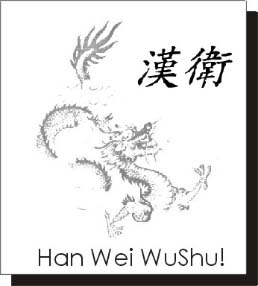Natural Traditional Chinese Martial Arts articles by Sal Canzonieri
This was my first column in Han Wei Wushu, it is about the essential elements of a complete Chinese martial arts system.

(April 1995 issue #12)
Article #1
Traditional Chinese Martial Arts Essentials...
ACHIEVING BALANCE & INTEGRATION IN A MARTIAL ART SYSTEM
=======================================================
By Salvatore Canzonieri, New Jersey
An integrated view of a martial art is one where a practitioner is in the center of a balanced interconnection of
essential elements. These essentials are:
1) Conditioning (stretching, body development);
2) Footwork (stepping and stances);
3) Physical Technique (Punching, Kicking, Grappling, Joint-Locking);
4) Chi & Nei Gung (internal training, proper breathing);
5) Forms (traditional juxtapositioning of postures and movements);
6) Meditation (spiritual development);
7) Self Defense (strategy); and
8) History (cultural development and context).
Only with the existence of these essential elements is a martial art system complete.
Each of these essentials unfolds from the other and exists in a harmonious balance in relationship to each other. When these
eight essentials are integrated together (experienced as a whole chain), they form a synergistic network that can be experienced
as more than just the sum of its parts. The feedback generated between the elements gives rise to an intelligence that speaks
directly to the practitioner. He/she can measure his/her performance, development, and growth in the system by measuring
the degree to which there is over or under emphasis on each of the elements. When balance is achieved, one finds his/herself in
the optimal center and is at one with the system. The practitioner becomes the embodiment of the essential elements and
thus able to directly transmit the systemþs ways and rules.
Thus, the essential elements that compose this integrated system work together with the practitioner to both reinforce and
effect each other so as to form a complete and intelligent system that is able to promote physical, mental, and spiritual growth
and well-being. The system acts like a "transformation" machine that changes it's user for the better. It is in the expression
of this positive change that causes one to be a true martial artist, for an artist is someone who can express his/her
environment in a unique way by creating a work of art that in turn effects other people experiencing the work.
These eight elements combine to describe both the rules (structure) and the ways (process flow) by which a martial art
system operates. By forming its structure, the elements create the organizing dimension of a system, allowing one to know how to
do what and (by interacting with the process flow) where. By forming its process flow, the elements create the planning
dimension of a system, allowing one to know when to do what and (by interacting with the structure) why. Together, they let one
operate successfully during a situation.
Furthermore, these eight elements are indeed essential to a martial art system because by overemphasizing planning (process
flow), a system disintegrates due to lack of rules and by overemphasizing organizing (structure), a system stagnates due to
lack of a variety of ways. Without a balance, a martial art system is both ineffective and inefficient, its rules being too
cumbersome and its ways being too confusing. For the practitioner, eventual disinterest or even harm is the result.
Without proper Conditioning, one lacks strength, stamina, and limberness, leading to debilitating wear. Without proper
Footwork, one lacks stability, grace, and mobility, making balance and maneuverability difficult. Without proper Physical
Technique, one lacks power, speed, and skill, leading to defeat. Without Chi/Nei Gung, one lacks internal energy, health, and
spirit, making for improper breathing and weakening of the organs. Without proper Forms, one lacks beauty, agility, and
ability, leading to waste. Without Meditation, one lacks serenity, vision, and insight, making doubt and confusion.
Without proper Self Deense, one lacks protection, confidence, and drive, leading to fear. Without History, one lacks purpose,
instruction, knowledge, and culture, making ignorance.
So, each element must be present in a martial art system or else it is not complete. One should examine his/her martial art
practice and observe whether he/she is at the center of a balanced network. It is rare today to find a school that encompasses all these eight essentials. Without them, a martial art style is neither a true art nor a complete system.
Traditional Chinese martial arts has all these essentials to offer. It has enabled Traditional Chinese martial arts to exist
for some 5,000 years, spreading throughout the world, changing to adapt to its environment, and influencing almost every other
martial art style known today. The continual survival and success of Traditional Chinese martial art can only be due to its
integrity in balancing the eight essential elements and thereby giving its practitioners a living, complete, and intelligent
training.
* Salvatore Canzonieri is a freelance artist & writer for various publications (Wushu Kungfu, Han Wei's Wushu, Seconds, EXIT, and
others), with experience in Taiji, Southern Shaolin, Northern Shaolin, Qigong and various other Traditional Chinese
Kungfu styles. He is currently researching material for a future Encyclopedia of Traditional Chinese Kungfu History and Forms *
That's it for this issue! Click here to read article #2
Sal Canzonieri -
Sal Canzonieri - http://www.bgtent.com/CMAQigongSchool/index.html